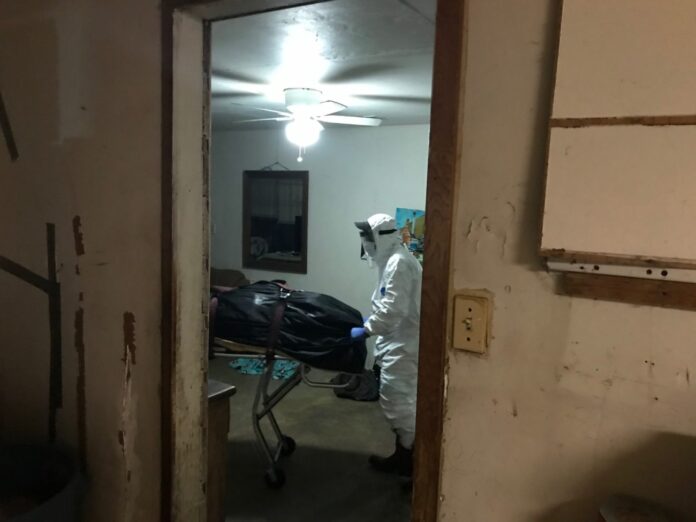Hidalgo County issued a statement on July 28 addressing a discrepancy between its coronavirus-related death toll and the tally reported by the Department of State Health Services.
On that day, the county was reporting 531 COVID-19 deaths and the state was reporting 254. As of Monday, Aug. 10, the county was reporting 829 COVID-19 deaths to the state’s 654.
The July release explained the discrepancy by stating that delays in the issuance of death certificates may be causing the difference in reporting, and outlined the county’s reporting process for coronavirus-related deaths.
It brooked other questions, such as exactly how are COVID-19 deaths being reported, where are these individuals dying and just how accurate are these death toll numbers?
According to Hidalgo County Health Authority Ivan Melendez, the fatality numbers are very accurate, about 95 to 99% accurate.
“Contrary to popular belief, there’s not much question what the patient dies from,” he said.
According to Melendez, about 90% of Hidalgo County’s coronavirus victims have perished in hospitals or nursing homes. He says most die in hospitals, followed by nursing homes.
“When you’re in a COVID ward, or you’re in a COVID nursing home ward, and you die and the reason you die is because you have an infection in your respiratory tract, I mean it’s pretty slam dunk,” he said. “That’s why you’re dying, you’re dying from COVID.

Melendez says the attending physician has five days to get the cause of death in the state electronic records system.
“When we’re declaring someone dies from COVID in Hidalgo County, we actually have lab proof that the patient indeed had COVID. So our numbers, I think, are a lot better than the state’s numbers, or a lot faster, and there’s no bias to them,” he said.
The county’s number recording system, Melendez said, is superior to the system used by many surrounding counties and even better than the state’s, in part because the county assigns an individual on its epidemiology team to track down coronavirus tests for fatalities related to the virus.
Melendez said there is a possibility of human error when it comes to COVID-19 data, although he thinks that it’s more likely in reporting positive cases than deaths. Counting a case twice, he said, would be an example of that type of error.
“We try to avoid that, we have a universal bank that we go back and look at, but as far as deaths, I don’t think that lends itself to overcounting to be quite honest,” he said.
What about the coronavirus patients who don’t die in a nursing home or a hospital? Melendez’s estimate of 10% of victims who die at home don’t have a hospital’s medical staff observing them and they don’t always have a positive COVID-19 test lying on the nightstand.
Melendez says he doesn’t know much about the procedure for determining whether or not those home deaths are classified as coronavirus-related. That decision, he says, falls to the justice of the peace, or sometimes to the deceased’s primary care doctor.
Precinct 4 Hidalgo County Justice of the Peace Charlie Espinoza says he and his personnel prefer to rely on a positive test when determining a COVID-19 death, but symptoms the deceased exhibited are also considered.
“If they tell the officer that he was (positive for COVID-19), most of the time I will try to get a confirmation of some kind from the family where he got tested,” he said. “Now if he hadn’t been tested and he had the symptoms, then I’d try to ask for his symptoms and then I might consider the COVID.”
Occasionally that determination can change on the ground. Juan Lopez, a body transporter based in McAllen, says he was called to the home of a man late last month and was told the occupant had died of natural causes.
When he arrived a little less than an hour later, Lopez said he was informed that it was a coronavirus-related death.
Espinoza says symptoms he asks for in determining whether a death was caused by COVID-19 are nausea, vomiting and breathing trouble.
“Especially if they were sick for three, four, five days before, it’s very possible that they had it,” he said.
The justice of the peace added that he doesn’t necessarily rely on other family members being positive for COVID-19 when he makes his determination.
“This virus is real funny,” he said. “You can’t pinpoint it, in my opinion. Just like some people get it real easy, some people will never get it. It’s kind of hard to make that determination.”
Also, not all coronavirus-positive people who die are added to the COVID-19 fatality roster, Melendez said.
A car crash victim who died of trauma in the wreck but was coincidently positive for the virus would not be added to the list, he said, nor would someone who was positive and died of natural causes that COVID-19 was not related to or only exacerbated as a contributing factor.
Claims that COVID-19 numbers are being inflated for financial gain, Melendez said, are categorically wrong.
“There’s no extra reimbursement for any diagnosis that you put down, so that’s nonsense,” he said.
Melendez also described reports of hospitals filling their coronavirus units with patients to make money as hogwash. He said there’s just no financial incentive for hospitals to keep COVID-19 patients from going home longer than necessary.
“They want to get the patient out quicker as opposed to later. They don’t sit there and ‘milk’ the patient because there’s some magic fund somewhere that’s giving money for COVID,” he said. “That’s just somebody’s imagination; that just doesn’t exist.”





